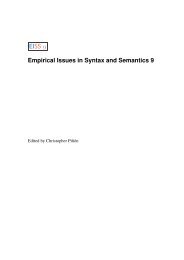More on the semantics of clitic doubling: principal ... - CSSP - CNRS
More on the semantics of clitic doubling: principal ... - CSSP - CNRS
More on the semantics of clitic doubling: principal ... - CSSP - CNRS
You also want an ePaper? Increase the reach of your titles
YUMPU automatically turns print PDFs into web optimized ePapers that Google loves.
<strong>the</strong> equati<strong>on</strong> <strong>of</strong> <strong>the</strong> formulas in (27), whereas <strong>the</strong> normal interpretati<strong>on</strong> is <strong>on</strong> <strong>the</strong> right side. The<br />
minimal witness set for m<strong>on</strong>ot<strong>on</strong>e decreasing quantifiers is <strong>the</strong> empty set and because <strong>the</strong><br />
empty set is <strong>the</strong> subset <strong>of</strong> any set, <strong>the</strong> left part <strong>of</strong> (27a) is a tautology, hence it is not equal to <strong>the</strong><br />
right side, which is simply <strong>the</strong> meaning <strong>of</strong> <strong>the</strong> quantifier at most three horses (<strong>the</strong> set <strong>of</strong> sets<br />
which include at most three horses). In (27b), <strong>on</strong> <strong>the</strong> o<strong>the</strong>r hand, <strong>the</strong> part <strong>on</strong> <strong>the</strong> left side is equal<br />
to <strong>the</strong> <strong>on</strong>e <strong>on</strong> <strong>the</strong> right side because <strong>the</strong> witness set <strong>of</strong> <strong>the</strong> weak quantifier three horses (<strong>the</strong> set<br />
<strong>of</strong> sets c<strong>on</strong>taining three horses) is identical to <strong>the</strong> meaning <strong>of</strong> <strong>the</strong> quantifier.<br />
(27) a. ∃P[P = ∅ ∧ P ⊆ Y] ≠ ∃X[|X| ≤ 3 ∧ X = ⟦horse⟧ ∩ Y]<br />
b. ∃P[P ⊆ ⟦horse⟧ ∧ |P|=3 ∧ P ⊆ Y] = ∃X[|X| = 3 ∧ X ⊆ ⟦horse⟧ ∩ Y]<br />
The topicality c<strong>on</strong>diti<strong>on</strong> draws a line between topicable and n<strong>on</strong>-topicable quantifiers. With<br />
some simplificati<strong>on</strong>, weak quantifiers, indefinites, and <strong>the</strong> universal all-quantifier are topicable,<br />
whereas m<strong>on</strong>ot<strong>on</strong>e decreasing quantifiers, n<strong>on</strong>-m<strong>on</strong>ot<strong>on</strong>e quantifiers, <strong>the</strong> universal quantifier<br />
every, and m<strong>on</strong>ot<strong>on</strong>e increasing quantifiers are n<strong>on</strong>-topicable. This is close (though not<br />
identical) to what we saw for <strong>the</strong> Albanian <strong>clitic</strong> <strong>doubling</strong> patterns. An excepti<strong>on</strong> are m<strong>on</strong>ot<strong>on</strong>e<br />
increasing quantifiers which may be <strong>clitic</strong> doubled in Albanian, even though according to <strong>the</strong><br />
topicality c<strong>on</strong>diti<strong>on</strong> <strong>the</strong>y are n<strong>on</strong>-topicable. But as Endriss (2009) herself acknowledges,<br />
matters are not so simple and straightforward, since even a m<strong>on</strong>ot<strong>on</strong>e increasing determiner<br />
such as <strong>the</strong> English several allows for a topical wide scope reading and n<strong>on</strong>-exhaustive<br />
interpretati<strong>on</strong>, as shown in (28) (from Endriss 2009, her example 6.44).<br />
(28) a. Several ma<strong>the</strong>maticians were at <strong>the</strong> party yesterday. They danced all night.<br />
b. The o<strong>the</strong>r ma<strong>the</strong>maticians at <strong>the</strong> party <strong>on</strong>ly drank a lot.<br />
The n<strong>on</strong>-exhaustive interpretati<strong>on</strong> <strong>of</strong> <strong>the</strong> quantifier several ma<strong>the</strong>maticians shows that it<br />
can be interpreted as a vague bare numeral weak quantifier similar to n. Under such an<br />
interpretati<strong>on</strong>, it can <strong>the</strong>n meet <strong>the</strong> topicality c<strong>on</strong>diti<strong>on</strong>.<br />
To c<strong>on</strong>clude this secti<strong>on</strong>, let us summarize our reas<strong>on</strong>ing so far: if we put aside <strong>the</strong><br />
informati<strong>on</strong> structure effects, <strong>the</strong> set <strong>of</strong> quantifiers which can be <strong>clitic</strong> doubled in Albanian<br />
c<strong>on</strong>sists <strong>of</strong> weak quantifiers (bare numeral and m<strong>on</strong>ot<strong>on</strong>e increasing quantifiers) and str<strong>on</strong>g<br />
quantifiers. Bare numerals and <strong>the</strong> all str<strong>on</strong>g quantifier are unc<strong>on</strong>troversially argued to be good<br />
candidates to be topics by Endriss (2009). As for m<strong>on</strong>ot<strong>on</strong>e increasing quantifiers, <strong>the</strong>y allow<br />
for a topical interpretati<strong>on</strong> under a n<strong>on</strong>-exhaustive interpretati<strong>on</strong>. Fur<strong>the</strong>r scrutiny<br />
notwithstanding, we assume that <strong>the</strong> same process <strong>of</strong> reinterpretati<strong>on</strong> is resp<strong>on</strong>sible for <strong>the</strong><br />
acceptability <strong>of</strong> m<strong>on</strong>ot<strong>on</strong>e increasing <strong>clitic</strong> doubled quantifiers in Albanian.<br />
The next secti<strong>on</strong> is dedicated to those str<strong>on</strong>g quantifiers which allow <strong>clitic</strong> <strong>doubling</strong> in<br />
Albanian but <strong>the</strong>ir status as topics (in a <strong>the</strong>ory like Endriss’) is at least c<strong>on</strong>troversial.<br />
3.2. Presuppositi<strong>on</strong>al determiners<br />
As was pointed out in §2.1, all DPs headed by str<strong>on</strong>g determiners may be <strong>clitic</strong> doubled in<br />
Albanian. The fact that <strong>the</strong> DPs headed by <strong>the</strong> str<strong>on</strong>g determiners çdo ‘every’, secilin ‘each’, të<br />
shumtët ‘most’, and asnjërin ‘nei<strong>the</strong>r (<strong>on</strong>e <strong>of</strong>)’/‘n<strong>on</strong>e (<strong>of</strong>)’ may be <strong>clitic</strong> doubled in Albanian –<br />
see <strong>the</strong> examples in (29) – is problematic for our attempt to explain <strong>the</strong> Albanian <strong>clitic</strong> <strong>doubling</strong><br />
purely algebraically, because singular universal quantifiers are assumed to be n<strong>on</strong>-topicable in<br />
Endriss’ (2009) analysis, as was dem<strong>on</strong>strated by <strong>the</strong> ungrammaticality <strong>of</strong> (20b).<br />
122











